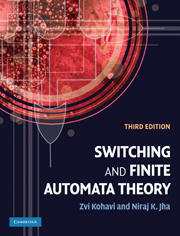2 - Sets, relations, and lattices
from Part 1 - Preliminaries
Published online by Cambridge University Press: 05 June 2012
Summary
The objective of this chapter is twofold: to develop the properties of partially ordered sets and lattices in an informal manner, and to furnish algebraic concepts necessary for the understanding of later chapters. The chapter develops in an intuitive manner the notions of sets, relations, and partial ordering, which together form the basis for the presentation of some results from lattice theory and, in Chapter 3, Boolean algebras. The chapter is by no means a complete treatment of the subjects but rather a survey of some results that bear upon material presented in later chapters.
Sets
A set S is intuitively defined as a collection of distinct objects. The readers of this book and prime numbers are examples of sets. The objects that form a set are called elements, or members, of that set, and the set is said to contain them. The membership of an element a in a set A is denoted by a ∈ A to mean “a is an element of A.” A set which has no element is called an empty or null set and is denoted φ. The elements contained in a set are either listed explicitly or described by their properties. This is accomplished by placing the elements or the describing property in braces.
Example The set of all even numbers between 1 and 10 is written as
{2, 4, 6, 8, 10}.
The infinite set of all positive even numbers can be described by
{2, 4, 6, …}.
The set
{all readers of this book who live in Antarctica}
is in all likelihood empty.
- Type
- Chapter
- Information
- Switching and Finite Automata Theory , pp. 23 - 34Publisher: Cambridge University PressPrint publication year: 2009



